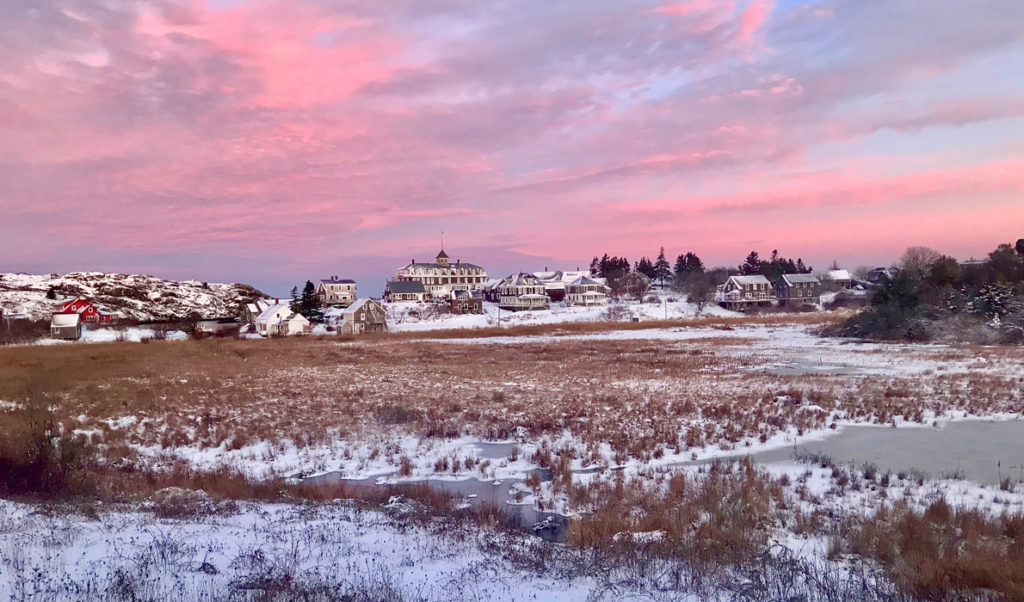By Robert Glennon
As Maine’s island communities and coastal residents address water supply problems created by rising sea levels (see “Monhegan’s water supply threatened,” December/January issue, they may want to borrow a tool developed in the arid West. Water harvesting involves capturing precipitation, whether rain, snow or sleet.
Saltwater intrusion into coastal groundwater aquifers has bedeviled Maine homeowners as well as others on the East, Gulf and West coasts. When water gets pumped from wells, the pumping creates a hydraulic vacuum that moves water, fresh or salt, laterally until the pressure subsides. Gravity relentlessly moves water to its lowest level. As ocean water warms, it expands and rises, thus creating its own hydraulic imbalance. Higher ocean levels increase the pressure for water to move into areas where the watertable is lower: our wells.
The city of Los Angeles has resisted saltwater intrusion for decades by pumping treated municipal wastewater into aquifers along the coast, thus creating a barrier to further lateral migration of seawater. That’s trickier to do in Maine, with its cracked granite formations. The common solution in Maine is to drill deeper wells in search of a subterranean aquifer unconnected to the shallower aquifer. That’s risky and expensive. What appears as a confined formation may turn out, after new wells begin to pump water, to have cracks in it.
Communities in the American West, such as Tucson, have employed techniques of water harvesting originally created by Native Americans a millennium ago. Hopi farmers still terrace their fields on hillsides allowing water to flow down from level to level, providing critical irrigation water along the way.
Today, Tucson residents make cuts into street curbs in order to capture rainwater flowing after monsoon events. At our home in Tucson, we harvest rainwater that hits our roof, funneling it into an 850-gallon cistern for later use or directly into basins to water shrubs and trees. We collect water for landscaping not indoor use. However, water harvesting could provide potable water.
On San Juan Island off the coast of Seattle, excessive groundwater pumping has caused the water table to drop and salt water to intrude into wells. Homeowners Teddy and Alice Dean worked with a company that specializes in building water catchment systems. They installed a corn silo down the hill from their home. It holds 15,000 gallons of water and has a rubberized liner to prevent leaks. During the Northwest’s rainy season, gutters and downspouts on the roof collect rainwater, which flows by gravity downhill to the silo.
The Deans installed a triple filtration system with two sediment filters and an ultraviolet electronic filter. This system brings rainwater up to drinking water quality. An electric pump at the bottom of the silo supplies water as needed. Maintenance is pretty simple: change the filters and ultraviolet bulb every nine months to the tune of $500. The entire system cost $15,000—a lot of money, to be sure. But it allows the Deans to continue living on an island with a sustainable year-round supply of water.
Mainers will need to overcome some obstacles before water harvesting becomes commonplace. Maine’s frigid temperatures and biting winds pose challenges not encountered in the temperate Pacific Northwest. Keeping the pipes and harvested water from freezing poses a formidable challenge. But Mainers are resourceful and resilient. Plumbers and builders will figure out what materials work best for constructing and insulating catchment systems.
Water harvesting could become a critical water supply tool for Maine’s island communities and coastal residents. Areas along the Maine coast get an average of 46 inches of rain a year; that’s more than Seattle gets. Why not put some of it to domestic use?
Robert Glennon divides his time between Port Clyde and Tucson, Arizona, where he is a Regents Professor at the University of Arizona College of Law. He is the author of Water Follies: Groundwater Pumping and the Fate of America’s Fresh Waters.





